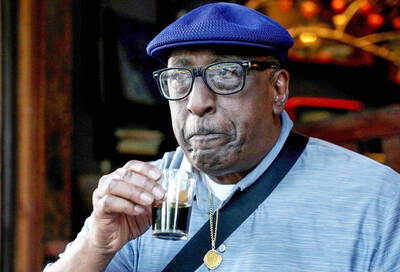Elizabeth Cameron Dalman became the pioneer of modern dance in Australia when she founded the Australian Dance Theater in 1965. It was the first modern dance group in her country and the first to be granted a government subsidy. For nearly forty years, Dalman has taught and collaborated with numerous dancers in various countries, including Taiwan.
One year after Grace Hsiao (

PHOTO: VICO LEE, TAIPEI TIMES
In Crossing Tracks II -- A Meeting of Two Cultures (
Sun and Moon, the opening piece of the show, is adopted from an Australian aboriginal legend, which represents the sun as a woman and the moon as a man.
"In modern dance, female dancers' movements are usually more activated and male dancers' more smooth. It's just like the legend," Dalman said.
This piece will be performed in Taiwan for the second time. Dalman staged it in 1971 when she was touring in Taiwan. Her performance so inspired Tsai Ruei-yuei (
Prayer, created in 1972, will probably strike a chord with audiences today with its human-rights theme and anti-war message. Based on a true story that occurred during the Troubles in Northern Ireland, the dance tells the tragic story of a Catholic girl who falls in a love with a Protestant soldier, then accidentally shoots him dead. Grace Hsiao's dancers act out the story with such precision and feeling that this piece is the highlight of the show.
The only shortcoming of this otherwise superb production is that Round-15 (
Crossing Tracks II -- A Meeting of Two Cultures will be performed at Round-15 Theater, 3F, 40-1 Chungshan N. Rd., Sec. 2, Taipei (

On April 26, The Lancet published a letter from two doctors at Taichung-based China Medical University Hospital (CMUH) warning that “Taiwan’s Health Care System is on the Brink of Collapse.” The authors said that “Years of policy inaction and mismanagement of resources have led to the National Health Insurance system operating under unsustainable conditions.” The pushback was immediate. Errors in the paper were quickly identified and publicized, to discredit the authors (the hospital apologized). CNA reported that CMUH said the letter described Taiwan in 2021 as having 62 nurses per 10,000 people, when the correct number was 78 nurses per 10,000

As we live longer, our risk of cognitive impairment is increasing. How can we delay the onset of symptoms? Do we have to give up every indulgence or can small changes make a difference? We asked neurologists for tips on how to keep our brains healthy for life. TAKE CARE OF YOUR HEALTH “All of the sensible things that apply to bodily health apply to brain health,” says Suzanne O’Sullivan, a consultant in neurology at the National Hospital for Neurology and Neurosurgery in London, and the author of The Age of Diagnosis. “When you’re 20, you can get away with absolute

May 5 to May 11 What started out as friction between Taiwanese students at Taichung First High School and a Japanese head cook escalated dramatically over the first two weeks of May 1927. It began on April 30 when the cook’s wife knew that lotus starch used in that night’s dinner had rat feces in it, but failed to inform staff until the meal was already prepared. The students believed that her silence was intentional, and filed a complaint. The school’s Japanese administrators sided with the cook’s family, dismissing the students as troublemakers and clamping down on their freedoms — with

As Donald Trump’s executive order in March led to the shuttering of Voice of America (VOA) — the global broadcaster whose roots date back to the fight against Nazi propaganda — he quickly attracted support from figures not used to aligning themselves with any US administration. Trump had ordered the US Agency for Global Media, the federal agency that funds VOA and other groups promoting independent journalism overseas, to be “eliminated to the maximum extent consistent with applicable law.” The decision suddenly halted programming in 49 languages to more than 425 million people. In Moscow, Margarita Simonyan, the hardline editor-in-chief of the